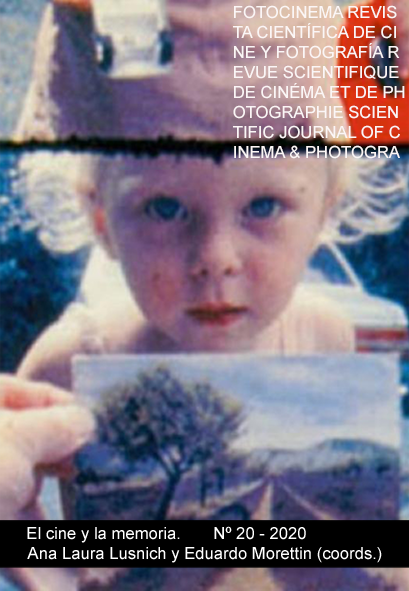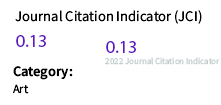Cinema memory. Intersections between documentary and fiction in contemporary Latin American cinematographic practice: a case study of Roma
DOI:
https://doi.org/10.24310/Fotocinema.2020.v0i20.7594Keywords:
memory cinema, documentary, experimental cinema, fiction, film practice, hybridizationAbstract
This paper explores the boundaries of documentary and fiction in the field of contemporary film practice in Latin America. Some trends from the cinematographic movement Nuevo Cine Latinoamericano are still valid today. These currents have been identified, following the revision of theories on the transit between both genres, from which we conducted the case study of the feature film Roma (Cuarón, 2018). The methodology used is structured in three phases, an initial literature review, which is followed by a work of documentation through interviews and testimonies of the author, as well as specialized criticism. Finally, a filmic analysis of the work under study is carried out using a model designed from the one proposed by Francisco Javier Gómez Tarín (2006), which addresses the film from three perspectives: contextual parameters, textual and language parameters and author parameters and significance. The results obtained confirm the hybridization of both genres through the mixture of stylistic and formal resources, placing the viewer at a critical distance from which an intimate and collective story is presented, close to the memory of three generations.
Downloads
Metrics
Publication Facts
Reviewer profiles N/A
Author statements
Indexed in
-
—
- Academic society
- N/A
- Publisher
- Universidad de Málaga
References
AFP. (24 Feb 2019). Alfonso Cuarón reinventó con "Roma" su forma de hacer cine. El Espectador. Recuperado de https://bit.ly/2QZsQlJ
Arias, J. C. (2010). Las nuevas fronteras del cine documental: la producción de lo real en la época de la imagen omnipresente. Aisthesis, (48), 48-65.
Barroso, J. (2009). Realización de documentales y reportajes: Técnicas y estrategias del rodaje en el campo. Madrid: Síntesis.
Bazin, A. (1966). ¿Qué es el cine? Madrid: Rialp.
Branigan, E. (2013). Narrative comprehension and film. New York: Routledge.
Bruzzi, S. (2000). New documentary: a critical introduction. New York: Routledge.
Castro, M. I. S. (2011). ¿Verdad o mentira?: la frontera imaginaria entre la ficción y el documental. En Cine español: arte, industria y patrimonio cultural (pp. 237-248). Instituto de la Cinematografía y de las Artes Audiovisuales.
del Toro, G. (13 de Enero de 2019). 6) Me parece que está poco difundido el hecho de que Cuarón y Eugenio Caballero reconstruyeron en un lote enorme, varias cuadras de la ciudad de Mexico- con banquetas, lámparas, asfalto, tiendas, etc, etc. Un logro titánico. @RealGDT. [Tuit]. Recuperado de https://twitter.com/RealGDT/status/1084717530961174528?ref_src=twsrc%5Etfw%7Ctwcamp%5Etweetembed%7Ctwterm%5E1084717530961174528&ref_url=https%3A%2F%2Fverne.elpais.com%2Fverne%2F2019%2F01%2F15%2Farticulo%2F1547547557_946418.html
del Toro, G. (13 de Enero de 2019). 8) Si ROMA cifra su narrativa en imagen y sonido, la pista sonora -escuchada en cine- es dinámica, envolvente y sutil- pero precisa. @RealGDT. [Tuit]. Recuperado de https://twitter.com/RealGDT/status/1084718157053362176?ref_src=twsrc%5Etfw%7Ctwcamp%5Etweetembed%7Ctwterm%5E1084718157053362176&ref_url=https%3A%2F%2Fverne.elpais.com%2Fverne%2F2019%2F01%2F15%2Farticulo%2F1547547557_946418.html
del Toro, G. (13 de Enero de 2019). 10) La imagen final rima con la inicial. Una vez mas tierra y cielo. Solo Cleo puede transitar entre ellos. Con la esencia que le permitió superar la prueba de Zovek. La cinta abre mirando hacia abajo y cierra mirando hacia arriba- pero el avión y el cielo, siempre estarán lejos. @RealGDT. [Tuit]. Recuperado de https://twitter.com/RealGDT/status/1084719617619124224?ref_src=twsrc%5Etfw%7Ctwcamp%5Etweetembed%7Ctwterm%5E1084719617619124224&ref_url=https%3A%2F%2Fverne.elpais.com%2Fverne%2F2019%2F01%2F15%2Farticulo%2F1547547557_946418.html
García Espinoza, J. (1969). Por un cine imperfecto. Madrid: Castellote Editores
Grass Kleiner, M. (2009). Imagen latente y Los rubios: Performatividad Cinematográfica y Estética de la Memoria en el Cine Latinoamericano. (Tesis de maestría), Universidad de Chile. Chile. Recuperado de https://bit.ly/2QZvY1b
Guimaraes, C. (2007). Documental y subjetividad. Una calle de doble mano. Artes y medios audiovisuales: un estado de situación.
Mullor, M. (14 de diciembre de 2018). Alfonso Cuarón y 'Roma': así es el peliculón de Netflix. Squire. Recuperado de https://bit.ly/2NyNrvg
Murillo, M. D. P. (2013). El cine latinoamericano entre dos siglos, sus claves y temas. Boletín americanista, (66), 81-99.
Navarro, S. J. (2002). Postmodernismo y metaficción historiográfica: una perspectiva interamericana (Vol. 8). Universitat de València.
Nichols, B. (1997). La representación de la realidad: cuestiones y conceptos sobre el documental. Paidós.
Orellana, J. (2003). La falsa frontera entre ficción y realidad en el cine: Una interpretación epistemológica del realismo de André Bazin y Andréi Tarkovski. Artículo. Recuperado de https://bit.ly/30qQaMx
Pancani, D. (2011). La Memoria filmada. Comunicación y Medios, (24), 188-200.
Paranaguá, P. A. (2003). Orígenes, evolución y problemas. En P. A. Paranaguá (Ed.), Cine documental en América Latina (pp. 13-78). Madrid, España: Cátedra.
Piedras, P. (2010). El problema de la primera persona en el cine documental contemporáneo. Modos de representar lo autobiográfico en ciertos documentales latinoamericanos. Cine Documental, (1).
Pugibet, V. (2017). Cine mexicano y migración: los pasos perdidos en La Jaula del oro de
Quemada-Díez. Comunicación y Medios, (36), 20-32. Recuperado de https://bit.ly/361T2jU DOI: 10.5354/rcm.v1i36.45754
Ramos Torre, R. (1989). Maurice Halbwachs y la memoria colectiva. Revista de occidente, (100), 63-81.
Russo, E. A. (2009). Cine documental contemporáneo en América Latina: la pregunta por lo real. Ventana Indiscreta, (002), 4-9. Recuperado de https://bit.ly/2FW8vYn
Solorzano, F. (01 de diciembre de 2018). Entrevista a Alfonso Cuarón “Con Roma quería honrar el tiempo y el espacio; que los lugares dictaran lo que iba a pasar”. Letras Libres. Recuperado de https://bit.ly/38ch2Ct
Tarín, F. J. G. (2006). El análisis del texto fílmico. Castellón: Beira Interior.
Valdés, M. (13 de diciembre de 2018). Alfonso Cuarón: la vida sin primeros planos. The New York Times. Recuperado de https://nyti.ms/3ads10h
Downloads
Published
How to Cite
Issue
Section
License
All contents published in Fotocinema Revista científica de cine y fotografía are protected under the Creative Commons Attribution-NonCommercial-ShareAlike 4.0 International (CC BY-NC-SA 4.0) license. All about this license is available in the following link: <http://creativecommons.org/licenses/by-nc-sa/4.0>
Users can copy, use, redistribute, share and exhibit publicly as long as:
- The original source and authorship of the material are cited (Journal, Publisher and URL of the work).
- It is not used for comercial purposes.
- The existence of the license and its especifications are mentioned.
There are two sets of authors’ rights: moral and property rights. Moral rights are perpetual prerogatives, unrenounceable, not-transferable, unalienable, imprescriptible and inembargable. According to authors’ rights legislation, Fotocinema. Revista científica de cine y fotografía recognizes and respects authors moral rights, as well as the ownership of property rights, which will be transferred to University of Malaga in open access. The property rights are referred to the benefits that are gained by the use or the dissemination of works. Fotocinema. Revista científica de cine y fotografía is published in an open access form and it is exclusively licenced by any means for doing or authorising distribution, dissemination, reproduction, , adaptation, translation or arrangement of works.
Authors are responsable for obtaining the necessary permission to use copyrighted images.














13.png)



